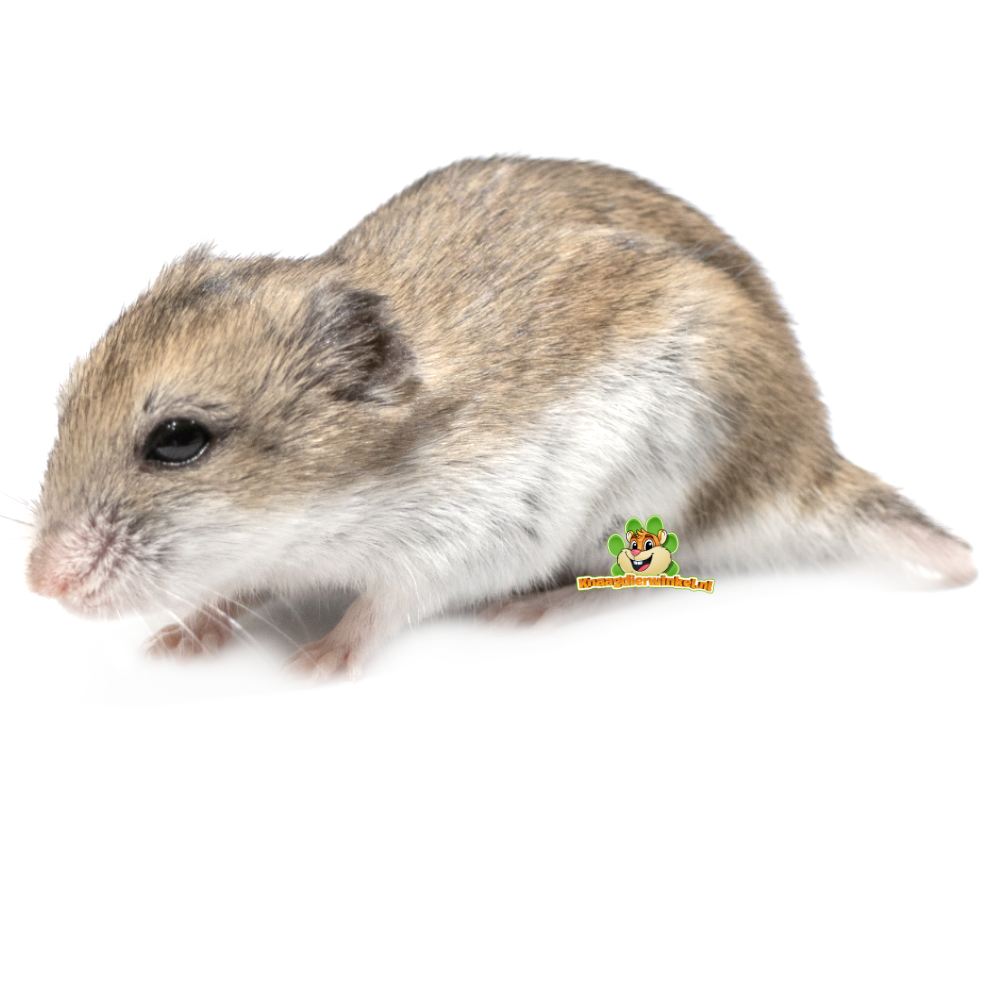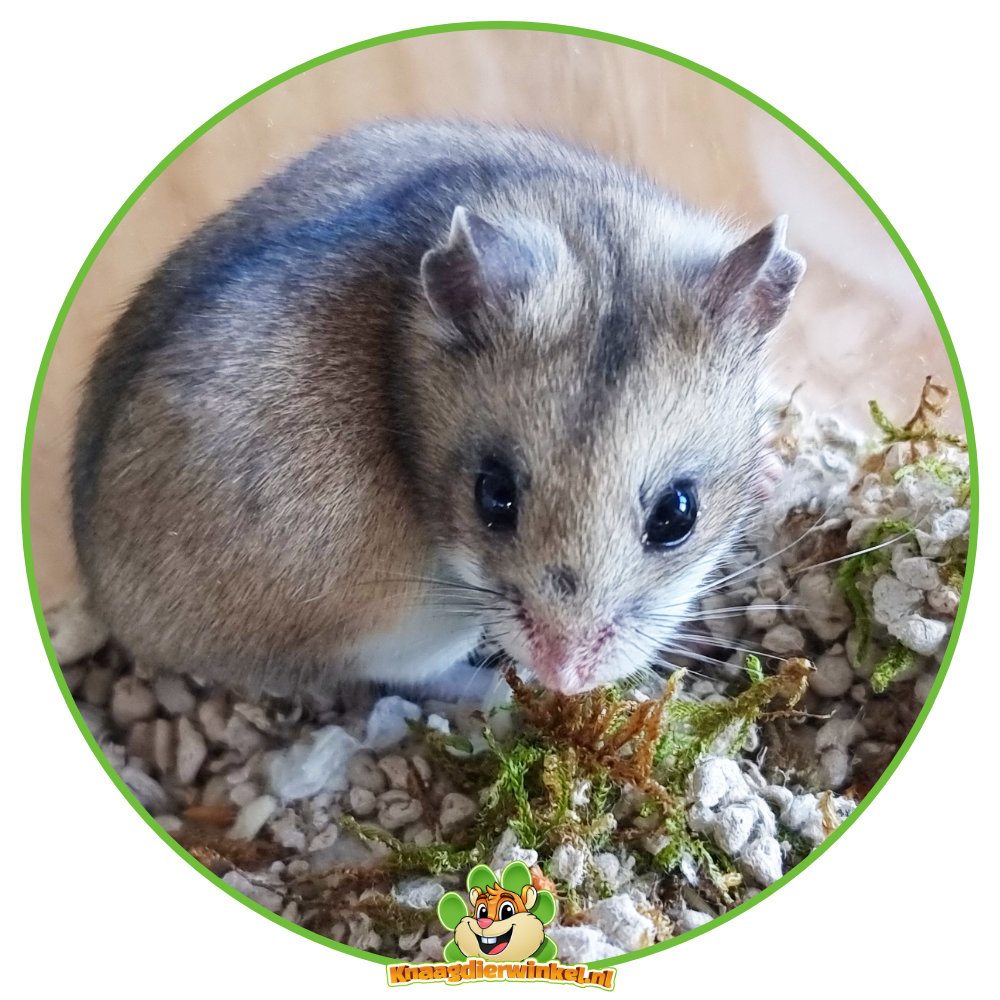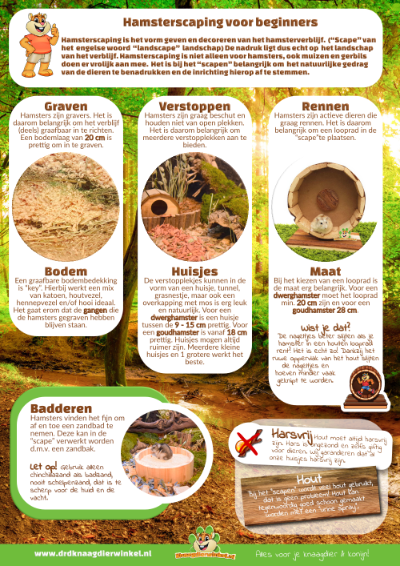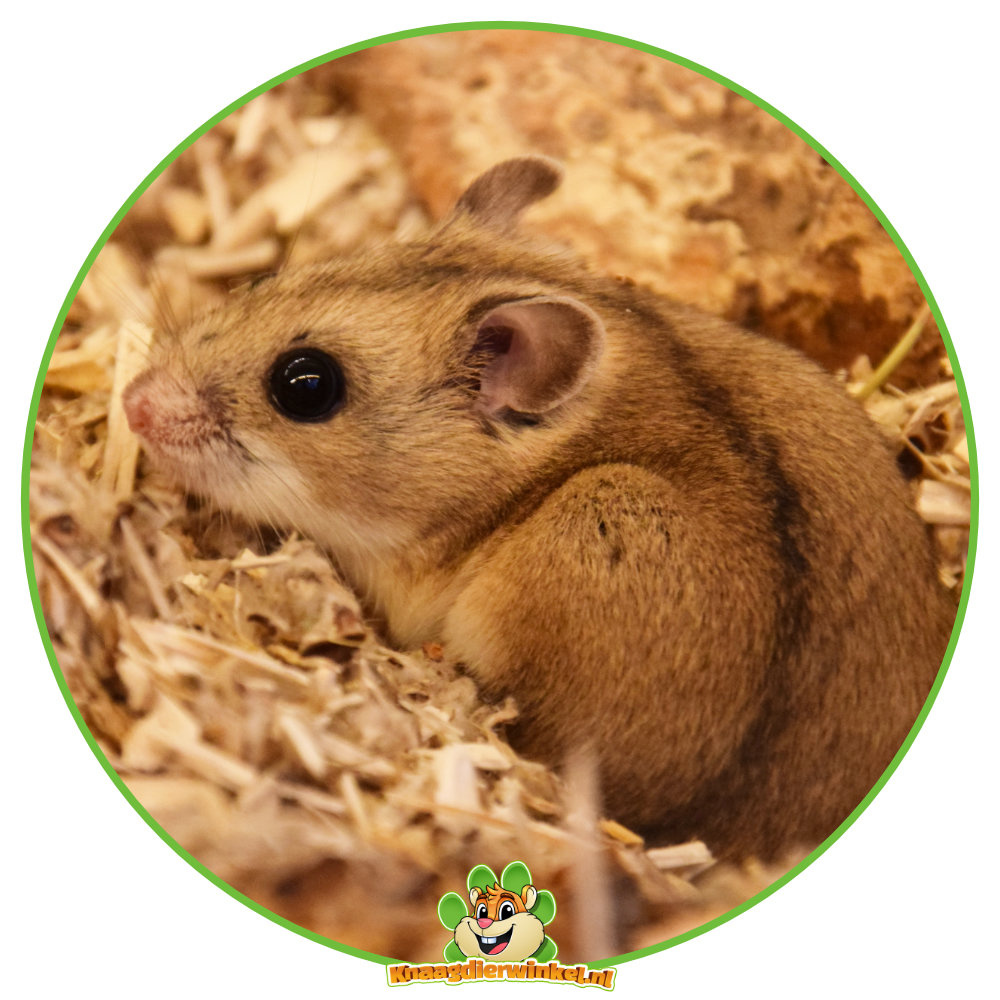
The Chinese Dwarf Hamster (Cricetulus griseus) is native to Tuva. It belongs to the long-tailed dwarf hamsters and is a shy animal. The Chinese has a longer body compared to the other dwarf hamster species and of course a longer tail. The tail helps the animal, among other things, to keep its balance when climbing.
The Chinese Dwarf Hamster was initially considered a subspecies of the Daurian Dwarf Hamster (Cricetulus Barabensis). They look very similar, but eventually the Chinese Dwarf Hamster was given the addition "griseus" instead of "Barabensis".
Head-body length : Males 11 - 12.5 cm and 45 grams, females 9 - 11 cm. and 38 grams
Body weight : Men 45 grams, women 38 grams
Life expectancy : 2 - 3 years
Chinese Dwarf hamsters are crepuscular, meaning they are most active in the evening and early morning. However, the animals sleep cyclically, i.e. a few hours of sleep alternate with a few hours of wakefulness, which means that these Dwarf hamsters are also regularly awake during the day.
 Tame and familiarize the Chinese Dwarf Hamster
Tame and familiarize the Chinese Dwarf Hamster
Always read carefully before you decide to get a Chinese Dwarf Hamster. They are very nice pets that are awake regularly, so they can also be seen during the day. The Chinese Dwarf Hamster does not always like to cuddle and he finds being picked up very scary, especially in the beginning. It appears that the Chinese Dwarf Hamster can see slightly more depth than the other Dwarf Hamster species, but caution is still advised. The longer tail of this Dwarf Hamster ensures that they can better maintain their balance on their hands, for example. Once they get used to the hands, they also enjoy walking over the hand and between the fingers.
A new resident should be approached calmly, especially during the first few months. The animal must first become familiar with its own enclosure and feel safe in it before it dares to approach people. Of course there are also daredevils who immediately walk up to you and are social, but most Hamsters are a bit shy at first. Give the animal time and try to make contact calmly by talking to the Hamster. Giving treats out of hand often works well to gain the animals' trust.
Housing for the Chinese Dwarf Hamster
Chinese Dwarf hamsters need a spacious enclosure of at least 80 x 40 cm. A good enclosure gives the animals the opportunity to dig, but also to climb a bit. In the wild, Chinese Dwarf Hamsters build beautiful corridors and they would like to continue to do so in captivity. A castle in the wild is located at a depth of at least 1 to 2 meters and is approximately 1 meter long. The depth of the castle depends on the ambient temperature. As temperatures rise, the dwarf hamster will dig deeper underground to reach the cool earth, a kind of natural air conditioning.
 Hamsterscaping is therefore very fun for Chinese Dwarf Hamsters.
Hamsterscaping is therefore very fun for Chinese Dwarf Hamsters.
At our home this translates into a spacious accommodation with digging possibilities! A terrarium is the best choice thanks to its closed nature. It is important that a terrarium allows good ventilation, so preferably it has two grilles (top and bottom). This is especially important in summer when temperatures rise above 25°C.
Chinese Dwarf Hamsters cannot tolerate high temperatures in combination with high humidity, so a temperature between 20 - 24°C and humidity below 70% is recommended. You can use a hygrometer to measure these values.
House for a Chinese Dwarf Hamster
Chinese Dwarf Hamsters are in luck! Because almost all houses made for hamsters have a good size for this dwarf hamster species. Chinese Dwarf hamsters are prey animals and do not like to walk around the enclosure openly, but if they occasionally come across a shelter they feel a lot safer. Our advice is therefore to have at least two houses for the Hamster. A house where the Dwarf hamster can sleep and another one where he can hide. At least one of the two houses must be larger so that the dwarf hamster can also store his food supplies there. Not being able to put away food supplies can cause stress for the animals.
Exercise wheel for a Chinese Dwarf Hamster
The hamster exercise wheel is a very important part of the design of the dwarf hamster enclosure. Chinese Dwarf Hamsters are active animals that like to run, often at night. This is because they naturally run a lot during the night in the search for food. So this is, as it were, in their DNA. In addition, scientific research has shown that running on an exercise wheel makes hamsters happy, digestion is improved and the animals generally remain in good condition by running.
A running wheel for a Chinese Dwarf Hamster must have a diameter of at least 20 cm and consist of a closed running surface.
Ground cover for the Chinese Dwarf Hamster
It is important that the ground cover is diggable for Dwarf Hamsters , which means that they can make corridors and holes in it, which preferably remain standing. This can be achieved by choosing ground cover that is already diggable in itself or mixing ground covers with each other so that they can be dug. Examples of excavable ground cover include Humus and Holenzand , but also Cotton & Cotton . A nice mix is, for example, the mix of Cotton & Hemp Fiber , Cotton & Wood Fiber or a mix of Wood Fiber , Hemp Fiber and Hay. Ground covers such as Back 2 Nature are not suitable because animals cannot dig in them. An ideal height of the ground cover for digging is around 20 cm.

Sand bath for Chinese Dwarf Hamsters
Chinese Dwarf Hamsters like to take a sand bath every now and then. Sand has a degreasing and therefore cooling effect. Because sand has a degreasing effect, it also has a drying effect. Animals with skin problems should therefore not be given a sand bath. If the sand dries out the skin too much, it can become itchy, causing the animals to bathe even more. It is therefore important to monitor the bathing behavior of the hamsters and to remove the sandbox if there are signs of skin problems (red spots, bald spots, scabs, wounds).
Chinese Dwarf Hamsters are nest builders
 Chinese Dwarf hamsters are real nest builders, they always need nesting material so that they can line their hole with it. Making a nest is therefore part of the natural behavior of a Dwarf hamster. Therefore, always give him 15-25 grams of nesting material.
Chinese Dwarf hamsters are real nest builders, they always need nesting material so that they can line their hole with it. Making a nest is therefore part of the natural behavior of a Dwarf hamster. Therefore, always give him 15-25 grams of nesting material.
Nesting material must be nice and soft, absorb moisture and have fragile fibers so that the animals cannot become entangled in it. Materials such as cotton, hemp, toilet paper and hay are ideal.
Chinese Dwarf Hamster food
Chinese Dwarf hamsters are true granivores (seed eaters). The diet of Chinese Dwarf hamsters consists mainly of seeds and an almost negligibly small part of animal proteins . The animals mainly eat more animal proteins such as insects when there are few seeds available.
Chinese Dwarf Hamsters carry their hamster food in their cheek pouches. What you see is that the hamster stuffs his food into his cheek pouches and quickly takes it to his house or pantry. Carrying food in the cheek pouches is also called 'Hoarding'. Thanks to the cheek pouch muscle, the food is held in the cheek pouch and the hamster can transport it safely and quickly.
Dental formula: 1013/1013 (Ratio of incisors at the top - bottom = 1: 2-3) Incisors continue to grow.
Molars do not continue to grow: The large cheek pouches that extend to the shoulder blades are a flexible protrusion of the buccal mucosa.
Stomach: consists of two chambers: the anterior stomach and the glandular stomach.
Small cecum: with limited ability to process crude fibers. Protein-rich cecal droppings are only eaten in case of food shortage.
The Chinese Dwarf Hamster does not actually eat plant parts, so the food should have a low fiber content and should certainly remain below 10%.
Gnawing material for Chinese Dwarf Hamsters
Chinese Dwarf Hamsters have a natural need to gnaw. This is because Dwarf hamsters are rodents and have continuously growing incisors. It is therefore necessary that they can gnaw on something to wear down the teeth. If dwarf hamsters have insufficient opportunities to wear down their teeth, the teeth may become too long or grow crooked, with all the consequences that entails.
Gnawing wood is used by rodents to wear down their teeth. Because rodents' teeth are always growing, they need to be gnawed regularly so that they do not grow too long and crooked.
Some Chinese Dwarf Hamsters gnaw wood very actively and others not at all. On the one hand it is a matter of taste, but on the other hand it is a matter of need. If a Dwarf hamster has no need to gnaw because its teeth are kept at their length through food, hay or other nibbles, it will gnaw less on wood. It is good to always provide natural gnawing wood so that the animals can always gnaw when they need to gnaw.
Dental problems in Chinese Dwarf hamsters
If you notice that your hamster is very enthusiastic about taking the food, but then does not eat it, there may be something wrong with its teeth. Drooling can also indicate dental problems. If you suspect that there are dental problems, it is best to contact your veterinarian.
Reproduction of the Chinese Dwarf Hamster
Chinese Dwarf Hamsters are 100% solitary, they only come together during mating season. Once young are born, the mother takes care of them until they are old enough to leave the nest.
The female is willing (in heat) and ready to mate every 4 days. This takes about 12 hours. If successful mating has taken place on these days, the young are born after approximately 19 days.
The difference between males and females can be seen in the distance between the genital opening and the anus. This distance is greater for a male than for a female.
Sexual maturity : from 4 weeks
Breeding mature: females from 12 weeks
Number of litters : 3-4 per year
Litter size : average 7 (max. 10) litters per litter
Gestation period : 19-21 days
Birth weight : 1-2 g, nest stayers
Weaning time : from week 3
Health of the Chinese Dwarf Hamster
Chinese Dwarf Hamsters are generally quite healthy animals. The most common health problems are dental problems, diabetes and eye problems. In connection with dental problems, we recommend checking them regularly to detect any dental problems in time.
It is not necessary to treat the animals preventively with anti-parasite. It is not necessary to provide extra vitamins with a complete hamster diet.
It is wise to consult a vet if you have the following symptoms:
Dental problems
Drooling, moist nose and eyes, protruding teeth, not eating, losing weight, eating foreign materials that are softer than the food.
Skin
Bald spots, lots of scratches, scabs, wounds, bumps and lumps.
Other
Wet and dirty ass, drinking a lot, falling over, lethargy, different shape and color of the feces.


